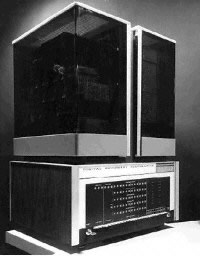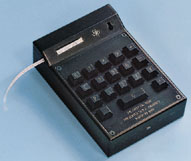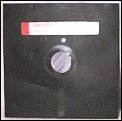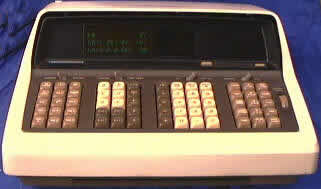|
The Industrial Era 1965 - 1968 In this part the emerging telecommunication is one of
the more important events. |
pre history | antiquity |
pre industrial era | industrial
era
| 1947 | 1950 | 1952 | 1955 | 1958 | 1961 | 1963 | 1965 | 1969 | 1970 | 1972 | 1974 | 1976 |
| 1978 | 1980 | 1981 | 1982 | 1984 | 1986 | 1989 | 1991 | 1993 | 1994 | 1996 | 2000 | 2002 |
| Related Articles |
| Related Resources |
history of videogames |
![]() The first glass
fiber cables are being used in a punch card reader of IBM.
The first glass
fiber cables are being used in a punch card reader of IBM.

![]() While some companies
were developing bigger and faster machines, Digital Equipment Corporation introduced
the PDP-8 in 1965, the first TRUE minicomputer. The PDP-8 had a minuscule instruction
set and a primitive micro-language, and excellent interface capability. Thus
the PDP-8 became used extensively as a process control system, including interfacing
to telephone lines for time-sharing systems.(19)
While some companies
were developing bigger and faster machines, Digital Equipment Corporation introduced
the PDP-8 in 1965, the first TRUE minicomputer. The PDP-8 had a minuscule instruction
set and a primitive micro-language, and excellent interface capability. Thus
the PDP-8 became used extensively as a process control system, including interfacing
to telephone lines for time-sharing systems.(19)
![]() Ted Nelson, an author
and futurist, coins the word "hypertext."
Ted Nelson, an author
and futurist, coins the word "hypertext."
![]() Douglas
Engelbart invents the computer mouse.
The first mouse Engelbart created was made of wood and metal wheels, see below
at 1967for details.
Douglas
Engelbart invents the computer mouse.
The first mouse Engelbart created was made of wood and metal wheels, see below
at 1967for details.

![]() The success of CTSS
at MIT was noted by J.C.R. Licklider, director of information processing research
at ARPA, who believed that the technology had useful applications in the agency.
He arranged to sponsor Project MAC (variously interpreted as "Machine Aided
Cognition", "Minsky Against Corbatů" and other names) that would
take the next logical stage in the development of time-sharing to produce a
system known as "Multics". Choosing a GE 600 series machine as the
basis for the development, MIT was joined by GE and AT&T Bell Laboratories
to produce a general-purpose, shared-memory multiprocessing timesharing system.(19)
The success of CTSS
at MIT was noted by J.C.R. Licklider, director of information processing research
at ARPA, who believed that the technology had useful applications in the agency.
He arranged to sponsor Project MAC (variously interpreted as "Machine Aided
Cognition", "Minsky Against Corbatů" and other names) that would
take the next logical stage in the development of time-sharing to produce a
system known as "Multics". Choosing a GE 600 series machine as the
basis for the development, MIT was joined by GE and AT&T Bell Laboratories
to produce a general-purpose, shared-memory multiprocessing timesharing system.(19)
![]() Maurice Wilkes develops
the first cache memory chip used in mainframe and minicomputers.
Maurice Wilkes develops
the first cache memory chip used in mainframe and minicomputers.
![]() IBM starts shipping
the 360 computer family. The series name 360 is derived from the compass of
360 degrees. This indicated that this family of computers were all compatible
within the 360 series. In this period of time (plug)compatibility was a revolutionary
insight of the developers to cope with the industrial malaise of trying to get
computers to talk to each other. Without using a translation table or rewriting
software that was nearly impossible, at this time.
IBM starts shipping
the 360 computer family. The series name 360 is derived from the compass of
360 degrees. This indicated that this family of computers were all compatible
within the 360 series. In this period of time (plug)compatibility was a revolutionary
insight of the developers to cope with the industrial malaise of trying to get
computers to talk to each other. Without using a translation table or rewriting
software that was nearly impossible, at this time.
 |
![]() Texas Instruments
is Founded
Texas Instruments
is Founded
![]() The acoustic modem
is strongly improved by John Green at Stanford
university. His modem improves the quality of computer networks because it now
can detect separate bits that have been sent from long distances. So far only
short distances were possible, within a building for example
The acoustic modem
is strongly improved by John Green at Stanford
university. His modem improves the quality of computer networks because it now
can detect separate bits that have been sent from long distances. So far only
short distances were possible, within a building for example
![]() Steven Gray founds
the Amateur Computer Society and starts publishing the Amateur Computer Society
ACS Newsletter issue 1 appeared in August 1966. This example will be followed
by many computer hobby clubs all over the world and will be the most important
medium to share information for time to come. Some of these newsletters will
become regular magazines other will disappear in a few years.
Steven Gray founds
the Amateur Computer Society and starts publishing the Amateur Computer Society
ACS Newsletter issue 1 appeared in August 1966. This example will be followed
by many computer hobby clubs all over the world and will be the most important
medium to share information for time to come. Some of these newsletters will
become regular magazines other will disappear in a few years.
Some say that by founding the ACS to be the birth date of personal computing.
(3)
![]() First WAN experiment
(ARPAnet) (13)
First WAN experiment
(ARPAnet) (13)

![]() The hand-held pocket
calculator was invented at Texas Instruments, Incorporated (TI) in 1966 by a
development team which included Jerry D. Merryman, James H. Van Tassel and Jack
St. Clair Kilby. In 1974 a basic patent for miniature electronic calculators
has been issued to Texas Instruments Incorporated. The patent is for personal-sized,
battery-operated calculators which have their main electronic circuitry in a
single integrated semiconductor circuit array, such as the popular "one-chip"
calculators. (1)
The hand-held pocket
calculator was invented at Texas Instruments, Incorporated (TI) in 1966 by a
development team which included Jerry D. Merryman, James H. Van Tassel and Jack
St. Clair Kilby. In 1974 a basic patent for miniature electronic calculators
has been issued to Texas Instruments Incorporated. The patent is for personal-sized,
battery-operated calculators which have their main electronic circuitry in a
single integrated semiconductor circuit array, such as the popular "one-chip"
calculators. (1)
Dynamic Random Access Memory (DRAM) cells, one-transistor memory cells that store each single bit of information as an electrical charge in an electronic circuit. The technology permits major increases in memory density, and is widely adopted throughout the industry where it remains in widespread use today.(2) |
 |
![]()
![]() Douglas Engelbart receives a
patent on the mouse pointing device for computers. He started research for this
mouse in 1965 .(3)
Douglas Engelbart receives a
patent on the mouse pointing device for computers. He started research for this
mouse in 1965 .(3)
On June 21, 1967, Doug Engelbart applied for a patent on his X-Y Position Indicator
for a Display System, now better known as the mouse. It was a device that he
had been thinking about and working on for more than a decade.
He publicly demonstrates the mouse one year later on the Online System. He also
demonstrated video conferencing and hypermedia. Those "inventions"
weren't designed to make money or create a product. Rather, they were part of
Engelbart's desire to "find much better ways for people to work together
to make this world a better place."
![]() The first Random Access
Memory - RAM - chip of 256 bits is developed by Fairchild Semiconductor
Inc. and will be announced in 1970. This chip contains over a thousand transistors.
The first Random Access
Memory - RAM - chip of 256 bits is developed by Fairchild Semiconductor
Inc. and will be announced in 1970. This chip contains over a thousand transistors.
 A team headed by David Noble from IBM starts the process
of developing the first floppy disk. IBM builds start with the development of
the floppy disk(3) Two years later it will be used
in IBM's System/370 mainframe machines
to replace the much slower paper tape. The read only floppy will contain a program
called Initial Control Program Load (IPL) (13)
such a programme is needed to boot a mainframe or section thereoff.
A team headed by David Noble from IBM starts the process
of developing the first floppy disk. IBM builds start with the development of
the floppy disk(3) Two years later it will be used
in IBM's System/370 mainframe machines
to replace the much slower paper tape. The read only floppy will contain a program
called Initial Control Program Load (IPL) (13)
such a programme is needed to boot a mainframe or section thereoff.
![]() The first office calculator
is now marketed: ANITA MARK 8 and is designed by Norman
Kitz.
The first office calculator
is now marketed: ANITA MARK 8 and is designed by Norman
Kitz.
![]() A dynamic memory cell
is being built into a chip by IBM. This means that now a bit only needs one
transistor. And as a result the densities on a chip can be drastically expanded.
A dynamic memory cell
is being built into a chip by IBM. This means that now a bit only needs one
transistor. And as a result the densities on a chip can be drastically expanded.
![]() In 1967 the LOGO "turtle"
was born. Seymour Paper designed the LOGO computer language as a learning tool
for children.(3)
In 1967 the LOGO "turtle"
was born. Seymour Paper designed the LOGO computer language as a learning tool
for children.(3)
![]() Grace Hopper becomes
project manager of a military work group that eventually will create the computer
language ADA. An homage to lady Ada
Lovelace.
Grace Hopper becomes
project manager of a military work group that eventually will create the computer
language ADA. An homage to lady Ada
Lovelace.
![]() Barclays Bank in the
UK claim to have installed the first cash dispenser in the
world in June 1967. This machine operates very different from today’s devices
(ATM). There are no magnetic cards; customers
are issued with paper vouchers which are inserted into the machine which retains
the voucher, and dispenses a single £10 note. Other banks use machines which
accepts thin plastic cards; these are returned to the customer through the post
after processing so that they can be used again. The dispenser machines are
far from reliable.
Barclays Bank in the
UK claim to have installed the first cash dispenser in the
world in June 1967. This machine operates very different from today’s devices
(ATM). There are no magnetic cards; customers
are issued with paper vouchers which are inserted into the machine which retains
the voucher, and dispenses a single £10 note. Other banks use machines which
accepts thin plastic cards; these are returned to the customer through the post
after processing so that they can be used again. The dispenser machines are
far from reliable.
![]() Andreas van Dam completes
the Hypertext Editing System, a program that allows non-sequential access to
the various parts of a document.(13)
Andreas van Dam completes
the Hypertext Editing System, a program that allows non-sequential access to
the various parts of a document.(13)
![]() IBM releases the 360/91
machine and introducing the concept of pipeline, which improve the performance
of a computer by 33 %. The pipeline is the computer equivalent of the assembly
line.(13)
IBM releases the 360/91
machine and introducing the concept of pipeline, which improve the performance
of a computer by 33 %. The pipeline is the computer equivalent of the assembly
line.(13)
![]() Development of Arpanet,
forerunner of the Internet, begins with U.S. Defense Department funding.
Development of Arpanet,
forerunner of the Internet, begins with U.S. Defense Department funding.
![]() The Garmisch Conference in Germany marks a turning
point in software development. At the conference scientists, engineers and industry
leaders, discuss the problem that software developers are unable to cope with
the advances in computer hardware. Here the term "Software Crisis"
is used for the first time.
The Garmisch Conference in Germany marks a turning
point in software development. At the conference scientists, engineers and industry
leaders, discuss the problem that software developers are unable to cope with
the advances in computer hardware. Here the term "Software Crisis"
is used for the first time.
A prime example of software getting over complicated:
IBM's operating system OS/360 is riddled with errors. To such a degree that it failed to operate properly and caused machines to crash for more than 4 hours.
The conference results in rough guidelines that eventually will lead towards a structured design methodology. That in its turn will yield fewer errors in software.(20)
![]() Douglas C. Engelbart,
of the Stanford Research Institute, demonstrates his system of keyboard, keypad,
mouse and windows at the Joint Computer Conference in San Francisco's Civic
Center. It demonstrates the use of a wordprocessor, a hypertext system, and
remote collaborative work (later coined as: "teleworking") with colleagues.
(3)
Douglas C. Engelbart,
of the Stanford Research Institute, demonstrates his system of keyboard, keypad,
mouse and windows at the Joint Computer Conference in San Francisco's Civic
Center. It demonstrates the use of a wordprocessor, a hypertext system, and
remote collaborative work (later coined as: "teleworking") with colleagues.
(3)
But Engelbart did not realize that however useful his ideas were, his machines
and software looked to the audience as coming from the far future. And when
asked for a price later on, the company he was paid by, set it much too high.
It meant the instant death for this project.
However Steve Jobs of Apple inc. picked up the ideas (on invitation of Rank Xerox themselves!) later on and went straight on to develop the Lisa (also much too expensive) and Mac Intosh (expensive but affordable) based on the ideas he saw at the Palo Alto Research Center (PARC).
![]() The first machines
based on the IC technology are being sold to the general public.
The first machines
based on the IC technology are being sold to the general public.
![]() IBM uses in their new
/360 systems CACHE memory, a super fast ram. This memory showed to
be 12 times as fast as the standard magnetic core memory, the average access
time was 80 ns. Very fast for this period.
IBM uses in their new
/360 systems CACHE memory, a super fast ram. This memory showed to
be 12 times as fast as the standard magnetic core memory, the average access
time was 80 ns. Very fast for this period.
![]()
![]() Gordon E. Moore,
Robert N. Noyce en William Shockley are leaving Fairchild and
found Intel (18.07.1968).
Gordon E. Moore,
Robert N. Noyce en William Shockley are leaving Fairchild and
found Intel (18.07.1968).
![]() The first working model
of VIRTUAL REALITY is ready.
The first working model
of VIRTUAL REALITY is ready.
![]() CMOS
- Complementary Metal Oxide Silicon - is developed. This technology uses less
power than the standard transistor technology. Because of that these chips are
very suitable for portable computer systems that run on batteries:
CMOS
- Complementary Metal Oxide Silicon - is developed. This technology uses less
power than the standard transistor technology. Because of that these chips are
very suitable for portable computer systems that run on batteries:
But it will take another 25 years before this CMOS technology really takes off.
![]() Commodore markets one
of the first electronic calculators. These machines were heavy, clumsy and could
only do the four basic calculations: ad, subtract, multiply, division.
Commodore markets one
of the first electronic calculators. These machines were heavy, clumsy and could
only do the four basic calculations: ad, subtract, multiply, division.

![]() Hewlett-Packard announces
their HP 9100A series calculator with CRT displays selling for about
$5000 each (21)
Hewlett-Packard announces
their HP 9100A series calculator with CRT displays selling for about
$5000 each (21)
![]() In 1955,
during the development of the programming language FORTRAN,
Harlan Herrick had introduced the high level language equivalent of a "jump"
instruction in the form of a "GO TO" statement.
In 1955,
during the development of the programming language FORTRAN,
Harlan Herrick had introduced the high level language equivalent of a "jump"
instruction in the form of a "GO TO" statement.
![]() In 1968 Edsger Dijkstra laid the foundation
in the march towards creating structure in the domain of programming by writing,
not a scientific paper on the subject, but instead a letter to the editor entitled
"GO TO Statement Considered Harmful". (Comm. ACM, August 1968)
The movement to develop reliable software was underway. (19)
In 1968 Edsger Dijkstra laid the foundation
in the march towards creating structure in the domain of programming by writing,
not a scientific paper on the subject, but instead a letter to the editor entitled
"GO TO Statement Considered Harmful". (Comm. ACM, August 1968)
The movement to develop reliable software was underway. (19)
![]() Arthur C. Clark introduced
HAL, the computer of the future in the movie "2001: A Space Odyssey",
basing the design on the artificial intelligence proposals of I.J. Good (a member
of Bletchley Park) and Marvin Minsky. Supposedly HAL was a monosyllabic cipher
of IBM! (19) It is also Clark who published the idea of satellites
in space (earth orbit) for communication.
Arthur C. Clark introduced
HAL, the computer of the future in the movie "2001: A Space Odyssey",
basing the design on the artificial intelligence proposals of I.J. Good (a member
of Bletchley Park) and Marvin Minsky. Supposedly HAL was a monosyllabic cipher
of IBM! (19) It is also Clark who published the idea of satellites
in space (earth orbit) for communication.
![]() Computer Science Corp.
becomes the first software company to be listed on the New York Stock Exchange.(13)
Computer Science Corp.
becomes the first software company to be listed on the New York Stock Exchange.(13)
![]() COBOL is now officially
defined by ANSI.(13)
COBOL is now officially
defined by ANSI.(13)
![]()
| Last Updated on October 25, 2004 | For suggestions please mail the editors |
Footnotes & References
| 1 | http://www.ideafinder.com/history/inventions/handcalculator.htm |
| 2 | IBM archives 1966 http://www-1.ibm.com/ibm/history/history/year_1966.html |
| 3 | Ken Olsson 1995, 1999 |
| 6 | Marcian E. "Ted" Hoff has the idea to design a micro processor. [ref: DOS 12/1988] |
| 8 | Ken Olsson 1995 |
| 9 | Port is used here in the sense of a gate where all in coming and out going 'bits' pass. |
| 10 | See appendix on Networks and Internet. |
| 11 | Dutch: CVE = Centrale Verwerkings Eenheid |
| 12 | ref:DOS 12/1988 p86 |
| 13 | Marian Bozdoc, Auckland NZ, www.bozdoc.f2s.com |
| 19 | www.computer.org - see for complete paper: http://www.acm.org/classics/ |
| 20 | History of the Internet, C.J.P. Moschovitis ea. p61 |
| 21 | source: aknight.home.mindspring.com |